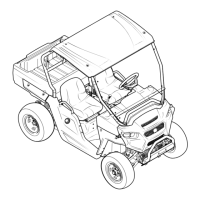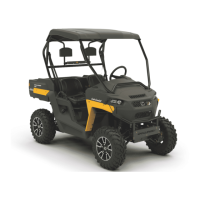Troubleshooting
Note:
If a large amount of air escapes from the exhaust pipe or through the throttle
body, the air is leaking through on open valve, Check the index mark to make
sure the engine is at TDC on the compression stroke, If the engine is remaining at
TDC but there is still a large amount of air escaping from the engine, the
crankshaft is off one revolution. Turn the engine 360°and realign the TDC mark as
described in Step 7, then relock it as described in Step8.
•
Air leaking through the exhaust pipe indicates a leaking exhaust valve.
•
Air leaking through the intake tract indicates a leaking intake valve.
•
Air leaking through both the intake and exhaust valves indicates the engine is
not set at TDC on its compression stroke.
•
Air leaking through the coolant filler neck indicates a leaking cylinder head
gasket or a cracked cylinder head or cylinder liner.
•
Air leaking through the oil filler hole indicates the rings are not sealing properly in
the bore.
•
If the cylinder leak down is 10 percent or higher, further service is required.
•
Disconnect the test equipment and install all the parts previously removed.
Electrical Testing
Preliminary Checks and Precautions
Refer to the color wiring diagrams at the end of the manual for component and
connector identification; Use the wiring diagrams to determine how the circuit should
work by tracing the current paths from the power source through the circuit components
to ground. Also, check any circuits that share the same fuse (if used), ground or switch.
If the other circuits work properly and the shared wiring is good, the cause must be in
the wiring used only by the suspect circuit. If all related circuits are faulty at the same
time, the probable cause is a poor ground connection or a blown fuse (if used).
As with all troubleshooting procedures, analyze typical symptoms in a systematic
manner. Never assume anything and do not overlook the obvious like a blown fuse or
an electrical connector that has separated. Test the simplest and most obvious items
first and try to make tests at easily accessible points on the UTV.
Before starting any electrical troubleshooting, perform the following:
•
Check the fuse if the fuse is blown, replace it.
•
Inspect the battery. Make sure it is fully charged, and the battery leads are clean
and securely attached to the battery terminals.
•
Disconnect each electrical connector in the suspect circuit and make sure there
are no bent terminals in the electrical connector.
•
Make sure the terminals on the end of each wire are pushed all the way into the
connector. If not. Carefully push them in with a narrow blade screwdriver.
•
Check the wires where they connect to the terminals for damage.

